We took our Bangkok Barcelona on Foot journey on the road (pun intended).
During our winter break in Catalonia, we shared our experiences via 60-90-minute question-and-answer sessions at three local libraries (biblioteca, in Catalan).
Biblioteca Vapor Vell – Barcelona
This is our neighborhood library, and it was an honor for us to meet our neighbors and friends there.
This library, more than any other in the city, gives us the sense of being home. For years, we have “camped out” on its long rows of tables, worked in communal silence, borrowed books and DVDs and attended cultural events and talks from other people on other adventures.
A few years ago when we decided to do Bangkok Barcelona on Foot (BaBa, is our nickname for the walk), Vapor Vell–which started as a velvet factory in the 1840s and, after a long history of other things, was converted into a municipal library in 2000–was our research center. We spent many hours there looking at maps, reading about places that seemed far away at the time and sketching out what would eventually become our route.
As with all things that matter, it’s the people who work at the library who make the place even more special. The library staff has been a valuable resource for us in many ways, lending us their professional and personal expertise, always with a smile and willingness to help. We’re grateful to them and the opportunity to do this Q&A.
In short, the conversation went really well. About 50 people, from college students to senior citizens, packed into the room, sitting on chairs, tables and wherever else they could squeeze in.
After a short introduction highlighting the “what we are doing” details, the audience laid questions on us for 75 minutes. There may have been more, but the library was closing and we had to call it a night.
Questions ran the gamut, starting with the typical ones we get: What do we eat, and where do we sleep (the answers are we eat whatever we find along the way as we peek into large pots at restaurants and drool over the out-of-the-oven bread burning our fingertips, and we sleep wherever the night finds us –camping near the side of the road, in dried rice fields, in people’s homes or gardens, in empty storage rooms at gas stations, in temples or schools and in the occasional hostel or hotel).
By the end of the session, we veered towards the transcendental: What is the motivation for our walk, and what have we learned that makes us better people? These questions are harder for us to answer because we don’t really have one concrete answer to give.
Our reason for walking is difficult to put into words, often because we, ourselves, don’t know really why this kind of journey speaks to us. And the lessons learned are hard to count or, better said, hard to measure when we compare what we knew before the walk and what we know now.
Lluís nails the motivation question. He loves traveling, walking is an intimate way to explore the world, we wanted to do a trip that would challenge us, and the people we meet along the way help us understand how much good is in the world.
I weave down existential avenues. My answer went something like this, “This walk is very hard, every single day. Walking with so much weight sucks, and I always want and need more water than I can carry. I quit several times a day. But, the moment a young boy on a bicycle comes up alongside us and says hello, with a big smile on his face, my walk becomes about him. I walk for him. I walk for all the people we meet. I walk for all the people who every day encourage us to continue.”
And how has this made us better people, and what have we learned? We’re not sure if the walk has made us better people or what we have learned has been processed in a way that we can yet fully write or speak about. What it has done is challenged our own persistence and resistance. It has broken me in many ways (Lluís remains tougher than me physically and mentally) and has reminded me to use the inner resources I have in new ways (such as fine-tuning my instincts and quickly reading people through their eyes and body language). These are questions we still have to ponder.
For now, we bow in your direction and say thank you to everyone who helped organize the event and to everyone who attended.
The view from the doorway; imagine the back wall on the right side of the photo with people sitting on tables:
The display and flyer that made us popular for an evening:
Biblioteca Torras i Bages – Vilafranca del Penedès
The Torras i Bages library in Vilafranca del Penedès, an hour train ride from Barcelona, has another special place in our hearts.
We spend many weekends in Vilafranca–it’s our “other Catalan home.” Vilafranca is Lluís’ second hometown, making Lluís half “vilafranquí,” a tag he wears with pride, especially when it comes to putting on the green shirt of the local human-tower group, the Castellers de Vilafranca. The library, too, is part of his life; when he wasn’t playing soccer with his friends or helping his grandmother, he was in this library studying.
Vilafranca is in his blood, and, by association, now in mine. We’re bound to run into someone we know strolling through its busy Saturday farmers’ market. We look forward to walking on trails winding through vineyards on the edge of town. And, sipping cava with old and new friends is a simple pleasure we savor.
This was our third Q&A chat (the list of this post is not in chronological order) and had our biggest showing. Some 60 people shared their evening with us. We knew many of the faces in the room; we were surrounded by family, friends from town and some castellers. And, the folks we didn’t know at the beginning of the night, we got to know based on the questions they asked. Questions, we think, are a reflection of a person’s inner knowing or their desire to know, and they say a lot about what’s in a person’s head and heart.
As with the other sessions, we led with a five-minute introduction about who we are and where we have walked so far. Then we opened it up for questions. We always wonder who will be brave enough to raise their hand and toss out the first question.
This time, we were proud of the young gentleman sitting in the front row. We have known Guillem since he was a little kid, and, now as he edges closer to being a teenager, we were happy to see him kick things off, without a moment´s hesitation. The fact that he was in a room crammed with adults didn´t seem to matter to him. We love this kid´s gusto.
He asked us a pointed question, which no one had asked us in the other sessions: Why are there gaps between the lines on your map? He was looking at the map we posted on the walls, and wondered why the line wasn´t completely filled in some places, particularly part of Burma, Pakistan, Afghanistan and Turkmenistan. The reason is because of geopolitics: We couldn´t get visas for some places, some borders between countries are closed and, even if we were lucky enough to get a visa, we may only be granted five days to walk 500 kilometers on the transit visa issued (walking 100 kilometers is far beyond our human strength).
While many other questions came from the middle of the room and the back of the room, it was another man, about our age, in the front row who led the charge of questions for 1h45m, until the library closed. He had a continuous string of questions and asked about how we chose the route, how much we spend, what technology devices we carry, how we managed to get visas, among others.
From the kinds of questions he asked, we´re convinced he has a long walking journey idea in his mind (and if he reads this, we would love to hear what it is). He reminded us of us around 2015 when we were mulling over BaBa and asked other walkers and outdoor explorers (namely Paul Salopek, Sarah Marquis, Albert Bosch and Tom Turcich) similar logistics and planning questions.
There were two other surprises during the evening: the town´s local television station ran a clip about us, and a student from one of the nearby universities was inspired to ask his professor if we could speak to his anthropology class (more about that below).
Thank you, Torras i Bages staff and our Vilafranca “fans” for putting us on your calendar. Hands on our hearts in gratitude for such a joyful evening. Your curiosity and interest in our journey move us forward.
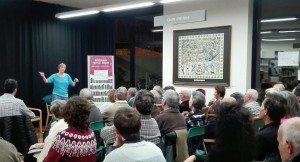 The library’s “come join us” flyer:
The library’s “come join us” flyer:

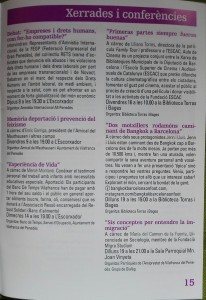 Website information promoting our Q&A:
Website information promoting our Q&A:
Biblioteca Jaume Fuster – Barcelona
It’s was a great experience to do a Q&A at the Jaume Fuster library, which specializes in travel.
It’s a spacious library where locals (including us) come with wanderlust and sit to listen in on a variety of cultural sessions, many of which highlight adventures of other travelers who visited places near and far. Lluís made a presentation here a few years ago, speaking about his year abroad studying in Australia and traveling through Asia.
The staff, a knowledgeable and friendly bunch, share the passion for travel. They were open to the idea of us trying out a less formal Q&A format instead of offering the traditional detailed, chronological presentation with a photo slideshow.
This was the first of the three planned sessions, and we weren’t sure how the Q&A would be received. Would people ask questions, or would they shy away? Would they miss the photos? Should we write details on the whiteboard, or would that be a distraction?
We decided to keep it super simple: Just the two of us up front, dressed informally (the way we would dress if we going to hang out in a library for the day), and a few copies of our route marked on a map taped to the wall, to give people geographical context.
Thankfully, the format worked.
We barely got through our five-minute introduction and people started asking us questions. How much weight are you carrying was the first one… and the answer is 23-25 kilos for me depending on much water I need, and 21-23 kilos for Lluís, who hauls less water than I do.
The questions kept coming from the lively group of 30-35 attendees… for 90 minutes, nonstop! And, they would have kept coming if the library wasn’t closing.
Questions came in rapid succession and ranged from what food we eat to how we manage not getting sick to if we had any bad encounters with animals and people to how we deal with cultural and language differences.
The short answers are: We eat what we find along the way (we ate versions of curried cauliflower very frequently during our seven months in Bangladesh and India, my least favorite vegetable and one I will try to avoid for forever forward). We have been happy that our stomachs have developed strength and immunity, but we were sick with diarrhea most of our time in the Pamirs (one of our favorite walking places) and, while we surprisingly survived India without many stomach-churning moments, we both got sick in tourist-crowded Varanasi. And, yes, we have had some sticky situations with people and animals (especially dogs in Thailand), but they have been minor inconveniences we weaved through.
For languages, we try to learn about 10-20 key words and numbers in every country, things like hello, thank you, water, food, tent and walking are the words we start with.
Like in any travel situation, observation is the best way to understand cultural differences, and we have absorbed many facets of cultural norms simply because we are going a slow way through the world at a maximum speed of 3-3.5 kilometers per hour.
What a fun night we had at Jaume Fuster library! Thanks for having us, and we hope to see again next time we’re home.
Answering all sorts of questions ( in Catalan!, always surprised to see how much vocabulary twists around my tongue):
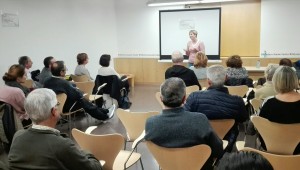 Announcing our 90-minutes of local fame:
Announcing our 90-minutes of local fame:
 The website Q&A call to the community:
The website Q&A call to the community:
Autònoma University´s Faculty of Letters
Universitat Autònoma de Barcelona – Facultat de Lletres
We ended up doing a fourth Q&A, thanks to an invitation from one of the attendees of the Vilafranca session. With the approval of his professor, we were invited to talk to an anthropology class at Autònoma University, not far from Barcelona.
The class, Visions Geogràfiques del Món (Geographic Visions of the World), is an introductory course about human geography, and some of the themes include migration; territory and urban growth; political power centers; globalization, and cultural identity. That context opened up 90-minutes of questions from about 50 students.
Not surprisingly, given the class focus, we got several questions about how we move in the world; how we confront issues related to our freedom of movement; how we deal with border crossings and police checks, and how our views about the social justice and injustice have shifted, especially as it relates to women’s rights (we were there a couple days before International Day of Women on March 8, and signs and murals around campus called for a strike to honor women’s equality).
None of these questions are easy to answer, and we can spend days writing blogs on any of these topics. We certainly have had our share of random police stops and some bureaucratic visa issues all along the way, but nothing that has truly hurt or scarred us. As much as these inconveniences boil our blood (and the same can be said about injustices many women in the world face, some of which we have witnessed), we try to our best to move through the world with grace, kindness, a smile and, sometimes, even indifference or detachment.
The sad truth is that the structures and institutions humans have created are difficult for the two of us to comply with, challenge or change. Humans the world over seemingly want structures that create division, that keep some people in and other people out. When we can and when we sense it may make a difference, we take a stand for what is right, but we do so with prudence. We must have a certain amount of acceptance and tolerance, mostly because we believe understanding is the bridge to compassion, but more practically, we don’t want to end up in jail in places where civil liberties may not be observed the way we think they should be. We continue to walk with our version of our truth, and a hope that somehow people see us connecting with people and the Earth in a way that is nearly forgotten.
Again, with hands on our hearts, we send a big thank you for the invitation to be part of your class. It was an education for us, too.
Classroom time
In the hallways, we found this sign, which translates to “One who does not move, does not feel the chains.” It reminded us of graffiti we found back in 2015 on another wall in Barcelona, which we wrote about in Catalan (desencadena’t) and in English (unchain yourself). It continues to make an impression on us.

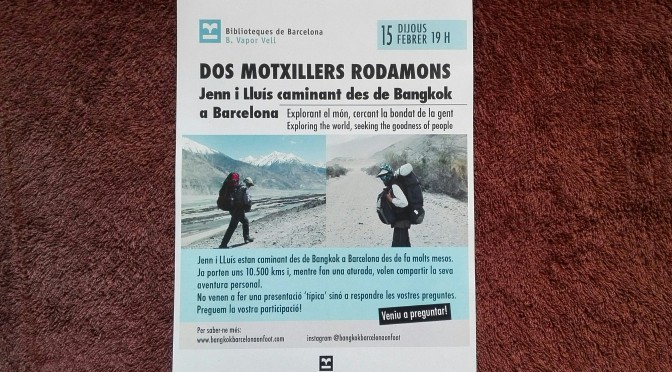






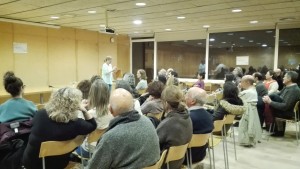
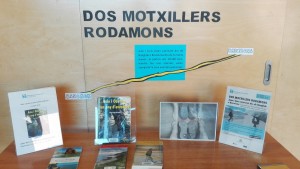
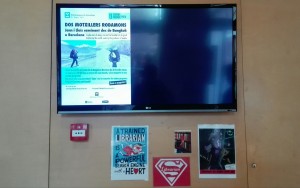

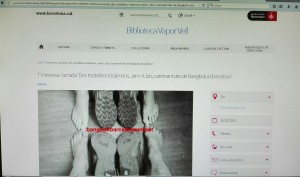

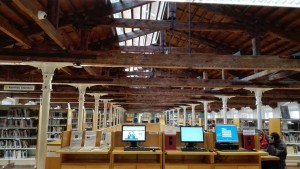

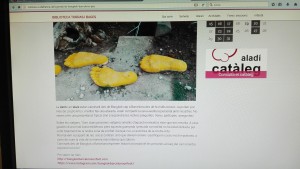
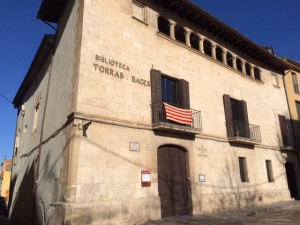


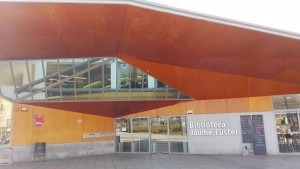
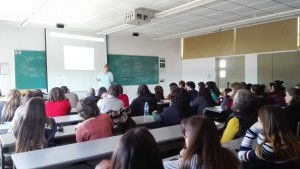
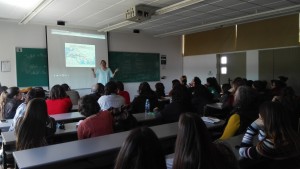
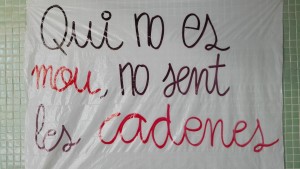
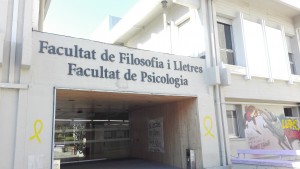
I love this post about bringing home your walk! What wonderful libraries you have.
Hi Bonnie,
They were fun chats. And, yes, we’re lucky to have such great places of inspiration nearby!
Hugs,
Jenn